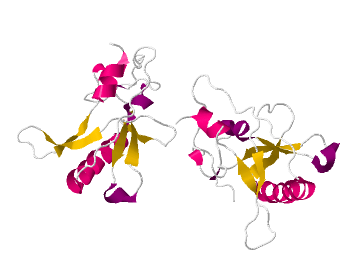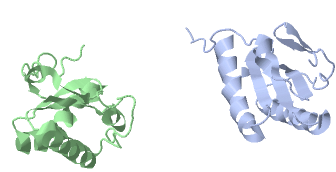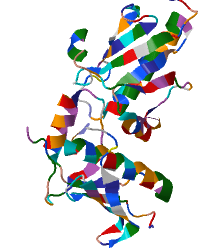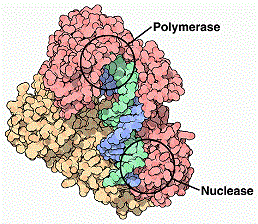AZT-resistant HIV-1 reverse transcriptase
From Proteopedia
| |||||||
| AZT-resistant HIV-1 reverse transcriptase with P66 (grey) and P51 (green) 3kli | |||||||
|---|---|---|---|---|---|---|---|
| Gene: | gag-pol (Human immunodeficiency virus 1) | ||||||
| Related: | 3kle, 3klf, 3klg, 3klh | ||||||
| |||||||
| Resources: | FirstGlance, OCA, PDBsum, RCSB | ||||||
| Coordinates: | save as pdb, mmCIF, xml | ||||||
Human Immunodeficiency Virus is a virus that damages the immune system of those affected by it. When a person is HIV positive, the virus infects the host's Helper T cells by attaching to the CD4 receptor on the host cell and fusing the viral envelope with the host cell membrane. The viral particles are then released into the host cell. Once inside the T cell cytoplasm, the viral enzyme, reverse transcriptase, coverts the virus' single stranded RNA into double stranded DNA. This capability classifies HIV as a retrovirus. The viral DNA is then incorporated into the host genome using the viral enzyme, integrase. The host genome now contains viral information and each time the host replicates, the viral genetic information is passed on to daughter cells. This makes HIV particularly difficult to treat, as it protects itself by incorporating its genetic information into that of the host. In addition, HIV is able to remain dormant in a host's body for a period of time before it hijacks the host cell and uses the host to create new viral particles.
Eventually, HIV infection leads to a weakened immune system, making a host more susceptible to opportunistic infections. The host's damaged immune system makes it more difficult to fight off infections and thus those who are HIV positive are more likely to have serious complications from common infections. This is especially concerning in those who have Acquired Immune Deficiency Syndrome (AIDS). Patients are considered to have AIDS when their CD4 cell count drops below 200 per microliter of blood. This means that their immune systems have been significantly damaged and puts them at great risk for opportunistic infections.
There is currently no cure for HIV/AIDS, but treatments that inhibit the replication of the virus do exist. These treatments, particularly AZT, will be discussed in the "Inhibition of Reverse Transcriptase Activity" section. Researchers are also attempting to create an HIV vaccine, but this is proving difficult because HIV is a retrovirus. The ability to convert single stranded RNA into double stranded DNA also creates for more opportunity for mutations of the virus to occur. The high frequency of viral mutations creates many challenges for scientists in the quest to create a vaccine. See also Reverse transcriptase.
Contents |
Role of Reverse Transcriptase in HIV Replication
Reverse transcriptase has two enzymatic activities: DNA polymerase and RNase H. DNA polymerase is capable of copying either a DNA or an RNA template, while RNase H cleaves RNA that is part of the RNA/DNA duplex. These functions work together to create double-stranded linear DNA from RNA, which can then be incorporated into the host genome
The viral RNA serves as the template for DNA polymerase, although a host tRNA primer initiates the synthesis. The primer allows reverse transcriptase to form the minus strand by copying the 5' end of the RNA. An RNA/DNA duplex is then formed from the synthesis of the minus strand and this duplex is the substrate for RNase H. RNase H degrades the RNA strand, leaving the newly formed minus strand of DNA. As DNA polymerase continues to create DNA, RNase H degrades the RNA. This process continues and the plus strand of DNA is created, forming a double-stranded linear DNA molecule.
Without reverse transcriptase, HIV would be incapable of incorporating itself into the host genome. Without this ability, it would be much easier for the host's immune system to destroy the virus, thus making it less harmful. Reverse transcriptase not only plays an important role in HIV replication, but also in the overall effectiveness of the virus.
Structure of Reverse Transcriptase
Reverse transcriptase is a heterodimer of two related : p66 and p51. The p66 subunit has 560 amino acid residues, while the p51 subunit has 440 amino acids. The larger subunit, p66, contains the active sites for both enzymatic activities (DNA polymerase and RNase H), while the smaller subunit, p51, has a structural role.
Two distinct domains, polymerase and RNase H form the p66 subunit. The polymerase domain consists of four subdomains: fingers (residues 1-85 and 118-155), palm (residues 86-117 and 156-236), thumb (residues 237-318), and connection (residues 319-426). The p51 subunit folds into the same subdomains, but the positions of the subdomains relative to each other are different.
 Fingers Subdomain
Fingers Subdomain  Palm Subdomain
Palm Subdomain
 Thumb Subdomain
Thumb Subdomain  Connection Subdomain
Connection Subdomain
The nucleic-acid binding cleft is primarily formed by the p66 polymerase and RNase H subdomains. The p51 thumb and connection subdomains form the floor of the binding cleft. In this way, the binding cleft is positioned so that both the polymerase and the RNAse H active sites come in contact with the nucleic acid.
When polymerase activity begins, reverse transcriptase binds to the nucleic acid substrate. This results in a conformational change in the position of the p66 thumb from a closed conformation to an open conformation. The p66 fingers subdomain then undergoes a conformational change which allows it to close down on the incoming dNTP, helping it to align the 3'-OH of the primer, the alpha-phosphate of the dNTP, and the polymerase active site. This is the rate-limiting step in the polymerization reaction. Following the slow step, phosphodiester bonds are formed between the newly incorporated nucleoside and the primer with the existing pyrophosphate. Eventually the fingers undergo another conformational change so that they can open and release the pyrophosphate from the active site.
The RNase H activity of reverse transcriptase is not currently well known. Because so much is known about the activity of polymerase, this is typically the target for reverse transcriptase inhibitors.
Inhibition of Reverse Transcriptase Polymerase Activity
Approximately half of all anti-HIV drugs target the polymerase activity of reverse transcriptase. Azidothymidine (AZT) is one such medication that affects reverse transcriptase. AZT is classified as a Nucleoside analog Reverse Transcriptase Inhibitor (NRTI), meaning that it is a nucleoside analog which impacts the polymerase activity of the enzyme. AZT is specifically a thymidine analog and AZT-sensitive HIV binds azidothymidine triphosphate (AZTTP) almost as efficiently as DNA thymidine triphosphate (dTTP). When reverse transcriptase binds AZTTP, the polymerase activity is halted because AZTTP lacks a 3'-OH for the next nucleotide to bind to. Without completion of polymerase activity, the virus is unable to use its RNA as a template for DNA and incorporate its genetic information into the host genome. Preventing reverse transcriptase from creating viral DNA can greatly impact the progression of the virus by slowing viral replication. This is complicated by the fact that many strains of HIV are able to develop resistance to AZT and other NRTIs.
AZT Resistance
There are two basic types of resistance mechanisms currently known for HIV-1:
1. exclusion- discrimination between AZTTP and dTTP at the time that AZTTP is incorporated
2. excision- removal of AZTTP from the viral DNA after it has been incorporated into the host genome
The excision mechanism has been shown to result from a set of mutations. Reverse transcriptase isolated from patients with AZT-resistant viruses do not typically have all of these mutations, however, combinations of the mutations give rise to high levels of resistance to AZT. AZT-resistant reverse transcriptase incorporates AZTTP just as efficiently as the wild-type, yet it has an improved ability to removed incorporated AZT from the 5' end of the template strand. A model that explains this process implies that because the addition of AZT to DNA destabilizes the closed complex, an AZT terminated primer has increased access to the active site so it can be excised. There are many complexities involved in this mechanism that are not currently understood.
The exclusion mechanism also results from a set of mutations. All amino acids involved in this mechanism exist in the finger or palm of reverse transcriptase in positions capable of affecting the binding of an incoming dNTP. There is little known about this mechanism, however, evidence suggests that some mutations cause changes in the hydrogen bonding network between the deoxyribose of an incoming dNTP and the enzyme. These changes increase the importance of the interactions of the enzyme with the 3'-OH and thus allow the mutant reverse transcriptase to better discriminate between normal dNTP which have 3'-OH and AZT which does not have a 3'-OH.
3D structures of AZT-resistant HIV-1 reverse transcriptase
3kli - P66/P51 (mutant)
3kle, 3klg, 3klh – P66/P51 (mutant) + DNA
Additional Information
For additional information, see HIV
References
Goodsell, David S. "September 2002 Molecule of the Month: Reverse Transcriptase" RCSB Protein Data Bank Web. 16 Nov. 2010. <http://www.rcsb.org/>.
Sarafianos et al. "Structure and Function of HIV-1 Reverse Transcriptase: Molecular Mechanisms of Polymerization and Inhibition." Journal of Molecular Biology Volume 385, Issue 3. 23 January 2009. 693-713
"Science." AIDS & HIV Information from the AIDS Charity AVERT. Web. 15 Nov. 2010. <http://www.avert.org/>.
Proteopedia Page Contributors and Editors (what is this?)
Alexandra Clement, David Canner, Michal Harel, Alexander Berchansky



